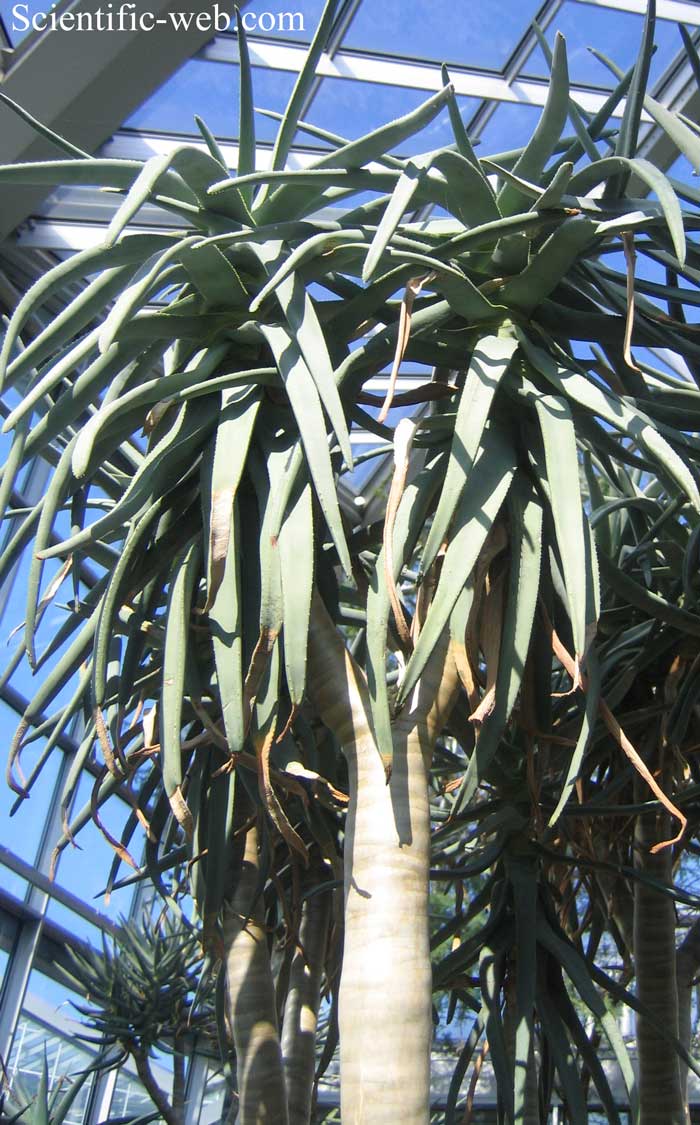
Aloidendron dichotomum, Photo: Michael Lahanas
lassification System: APG IV
Superregnum: Eukaryota
Regnum: Plantae
Cladus: Angiosperms
Cladus: Monocots
Ordo: Asparagales
Familia: Asphodelaceae
Subfamilia: Asphodeloideae
Genus: Aloidendron
Species: Aloidendron dichotomum
Name
Aloidendron dichotomum (Masson) Klopper & Gideon F.Sm., Phytotaxa 76: 9 (2013).
Synonyms
Basionym
Aloe dichotoma Masson, Philos. Trans. Roy. Soc. London 66: 310. 1776.
Homotypic
Aloe dichotoma L.f., Suppl. Pl. 206. 1782, comb. inval.
Rhipidodendrum dichotomum (Masson) Willd., Mag. Neuesten Entdeck. Gesammten Naturk. Ges. Naturf. Freunde Berlin 5: 166. 1811.
Heterotypic
Aloe ramosa Haw., Trans. Linn. Soc. London 7: 26. 1804.
Aloe montana Schinz, Bull. Herb. Boissier 4(3): 39. 1896.
Aloe dichotoma var. montana (Schinz) A.Berger in Engler (ed.), Pflanzenr., IV, 38: 319. 1908.
Distribution
Native distribution areas:
Aloidendron dichotomum
Continental: Africa
Regional: Southern Africa
Cape Provinces, Namibia.
References: Brummitt, R.K. 2001. TDWG – World Geographical Scheme for Recording Plant Distributions, 2nd Edition
References
Grace, O.M., Klopper, R.R., Smith, G.F., Crouch, N.R., Figueiredo, E., Rønsted, N. & Van Wyk, A.E. 2013. A revised generic classification for Aloe (Xanthorrhoeaceae subfam. Asphodeloideae). Phytotaxa 76(1): 7–14. DOI: 10.11646/phytotaxa.76.1.2 Open access ResearchGateReference page.
Links
Govaerts, R. et al. 2019. Aloidendron dichotomum in World Checklist of Selected Plant Families. The Board of Trustees of the Royal Botanic Gardens, Kew. Published online. Accessed: 2019 Feb. 21. Reference page.
International Plant Names Index. 2019. Aloidendron dichotomum. Published online. Accessed: Feb. 21 2019.
The Plant List 2013. Aloidendron dichotomum in The Plant List Version 1.1. Published online. Accessed: 2019 Feb. 21.
Tropicos.org 2019. Aloidendron dichotomum. Missouri Botanical Garden. Published online. Accessed: 21 Feb. 2019.
USDA, ARS, Germplasm Resources Information Network. Aloidendron dichotomum in the Germplasm Resources Information Network (GRIN), U.S. Department of Agriculture Agricultural Research Service. Accessed: 12 Aug 2006.
Vernacular names
Deutsch: Köcherbaum
English: Quiver tree,Aloe dichotoma
Nederlands: Kokerboom
Aloidendron dichotomum, formerly Aloe dichotoma, the quiver tree or kokerboom, is a tall, branching species of succulent plant, indigenous to Southern Africa, specifically in the Northern Cape region of South Africa, and parts of Southern Namibia.
Naming
Known as choje to the indigenous San people, the quiver tree gets its English common name from the San people practice of hollowing out the tubular branches of Aloidendron dichotomum to form quivers for their arrows. The specific epithet "dichotomum" refers to how the stems repeatedly branch into two ("dichotomous" branching) as the plant grows. This species was moved to the genus Aloidendron as Aloidendron dichotomum in 2013.[2]
Related species
Three separate species, A. dichotomum, A. pillansii and A. ramosissimum inhabit the same arid areas of the Richtersveld and the Namib Desert around the South African-Namibian border. The three have been given different ratings on the IUCN Red List of Threatened Species: 'vulnerable' for A. dichotomum, 'critically endangered' for A. pillansii and 'endangered' for A. ramossisimum.
The three species can be distinguished. In A. pillansii, the inflorescences hang from below the lowest leaves, rather than growing erect. A. ramosissimum is considerably smaller—rarely reaching more than 2 m in height—and assumes a more shrub-like shape. While there is a gradation between tree-like A. dichotomum and the shrubby A. ramosissimum, the relatively unique A. pillansii population is separated by a different flowering time and therefore does not interbreed with the other two species.[3]
Distribution and conservation
One of the few examples of spontaneous forests of A. dichotomum is the Quiver Tree Forest, about 14 km north of Keetmanshoop, in Namibia. Another is located in the Northern Cape of South Africa at Gannabos.
Throughout much of its range this species is in decline. Modeling of Aloidendron dichotomum in South Africa and Namibia has contributed to understanding the needs of protected areas in response to climate change. Modelled range declines in this species due to climate change have recently been confirmed by field surveys.[4]
Cultivation
Aloidendron dichotomum is cultivated in arid areas around the world, for use in landscaping. The slow growth rate and relative rarity of the plant make it a particularly expensive specimen. It is also relatively difficult to keep outside of its natural habitat.
In cultivation it requires extremely well-drained coarse mineral sand (preferably with some loam and bone meal to keep it active and growing), full sun, good aeration and extremely little water - primarily in the winter (as it mainly occurs in winter rainfall desert). In the (rare) event that it is under-watered, the leaves will curl up and die off at the tips; this is not fatal, but indicates that it is relatively dry.
It is unusually prone to aphids and insect infections in between its leaves, and this is exacerbated whenever there is not full sun and constant fresh air movement. Indoor plants require frequent treatment for these pests. Fungicide can also be added occasionally, to protect from rot.
It can be propagated from seed and (with more difficulty) from cuttings or truncheons. Cuttings need to be thoroughly dried for several weeks in a shaded area, before being planted.[5]
In popular culture
Michael Benson's book Space Odyssey: Stanley Kubrick, Arthur C. Clarke, and the Making of a Masterpiece (2018) briefly discusses how the kokerboom piqued the interest of film director, Stanley Kubrick. The book claims that several protected kokerboom trees were cut down so they could be used to film 2001: A Space Odyssey.[6]
See also
Aloidendron barberae
References
"Aloidendron dichotomum". World Checklist of Selected Plant Families. Royal Botanic Gardens, Kew. Retrieved 16 October 2017.
https://www.biotaxa.org/Phytotaxa/article/view/phytotaxa.76.1.2
Court, D. (2010). Succulent Flora of Southern Africa. Cape Town: Struik Nature. ISBN 978-1-77007-587-0.
Foden, Wendy; Midgley, Guy F.; Hughes, Greg; Bond, William J.; Thuiller, Wilfried; Hoffman, M. Timm; Kaleme, Prince; Underhill, Les G.; et al. (2007). "A changing climate is eroding the geographical range of the Namib Desert tree Aloe through population declines and dispersal lags" (PDF). Diversity and Distributions. 13 (5): 645–653. doi:10.1111/j.1472-4642.2007.00391.x. S2CID 53662810. Retrieved 16 July 2011.
"Aloe dichotoma". Retrieved 26 September 2016.
Space Odyssey: Stanley Kubrick, Arthur C. Clarke, and the Making of a Masterpiece. (2018) p. 277.
Retrieved from "http://en.wikipedia.org/"
All text is available under the terms of the GNU Free Documentation License

